- Qu'est-ce que c'est JSTL?
- Aperçu sur les fonctionnalités de JSTL
- Téléchangement la bibliothèque JSTL
- Créez le projet de l'application web
- Déclaration la bibliothèque JSTL
- Configuration pour exécuter Webapp
- Les classes ont participé dans les exemples
- Les tages basiques de JSTL (JSTL Core Tags)
- JSTL Formatting and Localization Tags
Le Tutoriel de Java JSP Standard Tag Library (JSTL)
1. Qu'est-ce que c'est JSTL?
2. Aperçu sur les fonctionnalités de JSTL
Functions | Description / Declaration |
Core Tags | Core tags provide support for iteration, conditional logic, catch exception, url, forward or redirect response etc. To use JSTL core tags, you should include it in the JSP page like below. |
Core Tags |
|
Formatting and Localization Tags | These tags are provided for formatting of Numbers, Dates and i18n support through locales and resource bundles. You can include these tags in JSP with below syntax: |
Formatting and Localization Tags |
|
SQL Tags: | JSTL SQL Tags provide support for interaction with relational databases such as Oracle, MySql etc. Using SQL tags you can run database queries, you include it in JSP with below syntax: |
SQL Tags: |
|
XML Tags | XML tags are used to work with XML documents such as parsing XML, transforming XML data and XPath expressions evaluation. Syntax to include XML tags in JSP page is: |
XML Tags |
|
JSTL Functions Tags | JSTL tags provide a number of functions that you can use to perform common operation, most of them are for String manipulation such as String Concatenation, Split String etc. Syntax to include JSTL functions in JSP page is: |
JSTL Functions Tags |
|
3. Téléchangement la bibliothèque JSTL
- <Tomcat>/webapps/examples/WEB-INF/lib
- taglibs-standard-impl-**.jar
- taglibs-standard-spec-**.jar
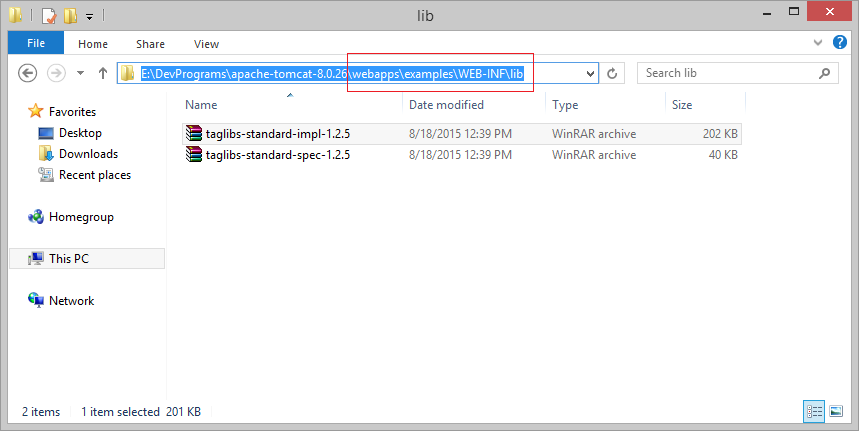
JSTL library (Provided by Apache) | JSTL library (Provided by Glassfish) |
taglibs-standard-spec-*.jar | javax.servlet.jsp.jslt-api-*.jar |
taglibs-standard-impl-*.jar | javax.servlet.jsp.jstl-*.jar |
- Fourni par Apache:
<!-- taglibs-standard-spec-*.jar -->
<!-- http://mvnrepository.com/artifact/org.apache.taglibs/taglibs-standard-spec -->
<dependency>
<groupId>org.apache.taglibs</groupId>
<artifactId>taglibs-standard-spec</artifactId>
<version>1.2.5</version>
</dependency>
<!-- taglibs-standard-impl-*.jar -->
<!-- http://mvnrepository.com/artifact/org.apache.taglibs/taglibs-standard-impl -->
<dependency>
<groupId>org.apache.taglibs</groupId>
<artifactId>taglibs-standard-impl</artifactId>
<version>1.2.5</version>
</dependency>- Ou fournit par Glassfish:
<!-- http://mvnrepository.com/artifact/org.glassfish.web/javax.servlet.jsp.jstl -->
<dependency>
<groupId>org.glassfish.web</groupId>
<artifactId>javax.servlet.jsp.jstl</artifactId>
<version>1.2.4</version>
</dependency>
<!-- http://mvnrepository.com/artifact/javax.servlet.jsp.jstl/javax.servlet.jsp.jstl-api -->
<dependency>
<groupId>javax.servlet.jsp.jstl</groupId>
<artifactId>javax.servlet.jsp.jstl-api</artifactId>
<version>1.2.1</version>
</dependency>- Fourni par Sun (Version un peu ancienne, rare utilisé actuellement).
<!-- standard.jar -->
<!-- http://mvnrepository.com/artifact/taglibs/standard -->
<dependency>
<groupId>taglibs</groupId>
<artifactId>standard</artifactId>
<version>1.1.2</version>
</dependency>
<!-- jstl-*.jar -->
<!-- http://mvnrepository.com/artifact/javax.servlet/jstl -->
<dependency>
<groupId>javax.servlet</groupId>
<artifactId>jstl</artifactId>
<version>1.2</version>
</dependency>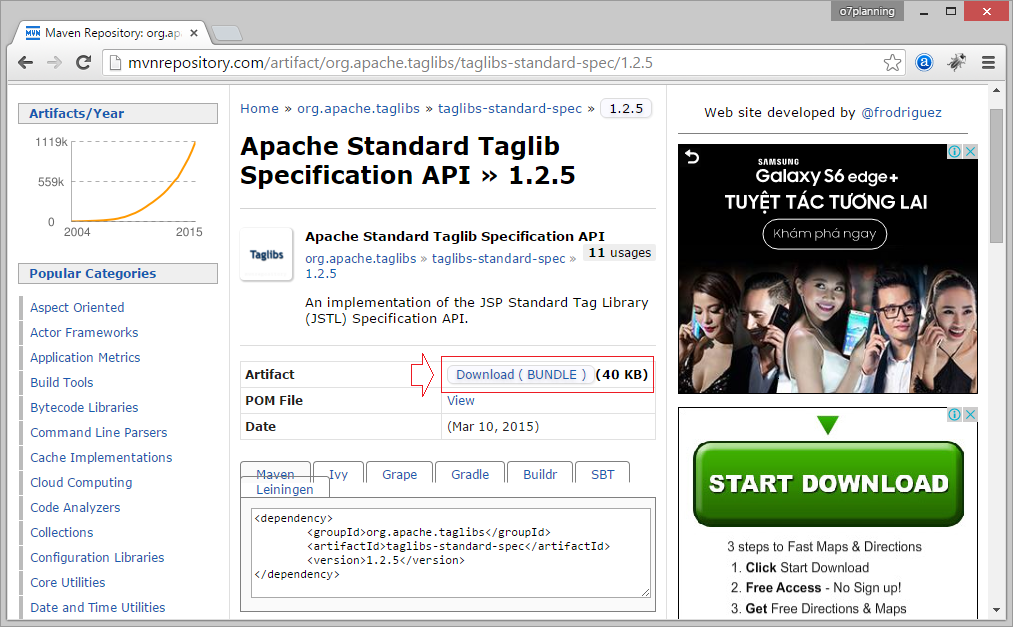
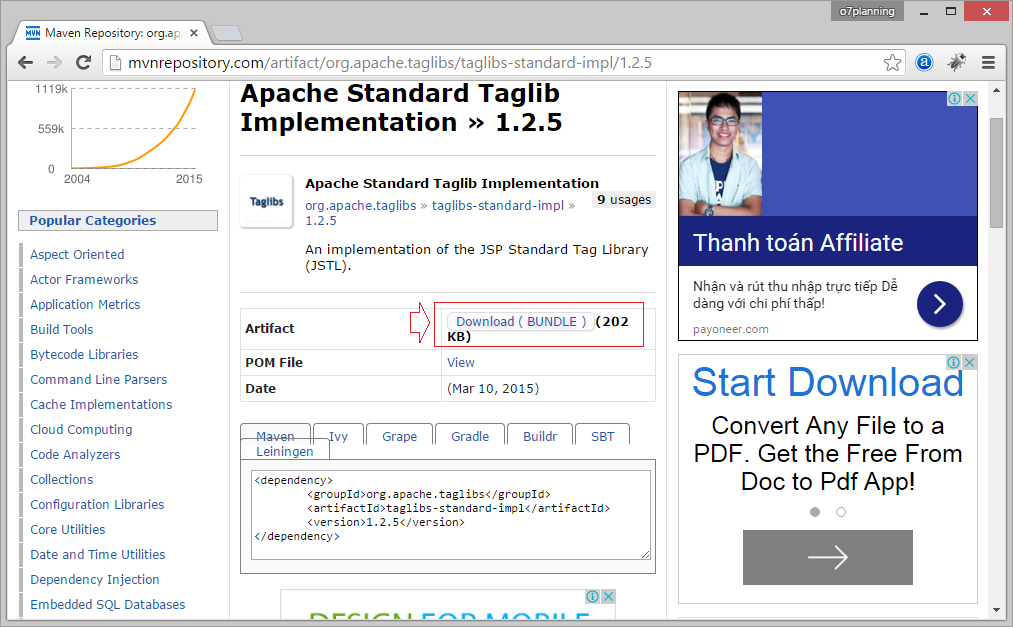
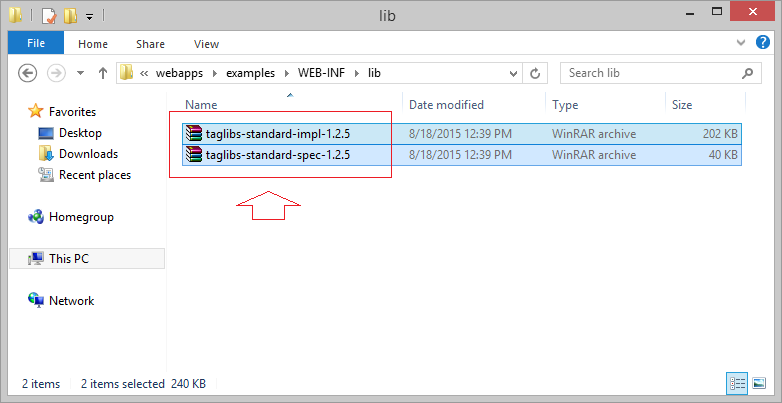
4. Créez le projet de l'application web
- File/New/Other..
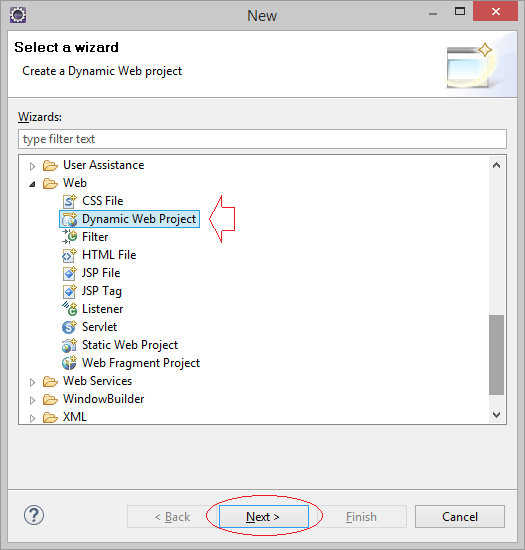
- JSTLTutorial
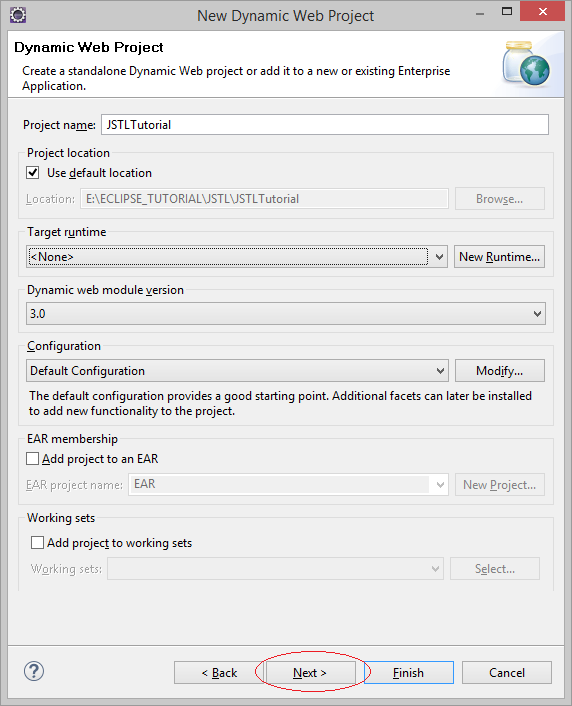
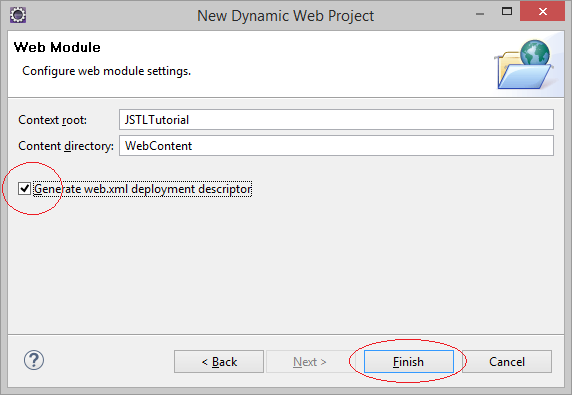
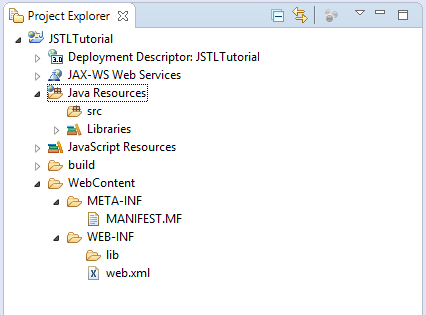
5. Déclaration la bibliothèque JSTL
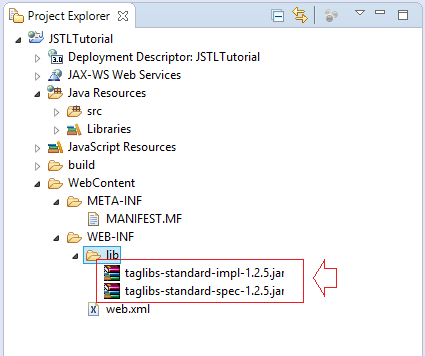
6. Configuration pour exécuter Webapp
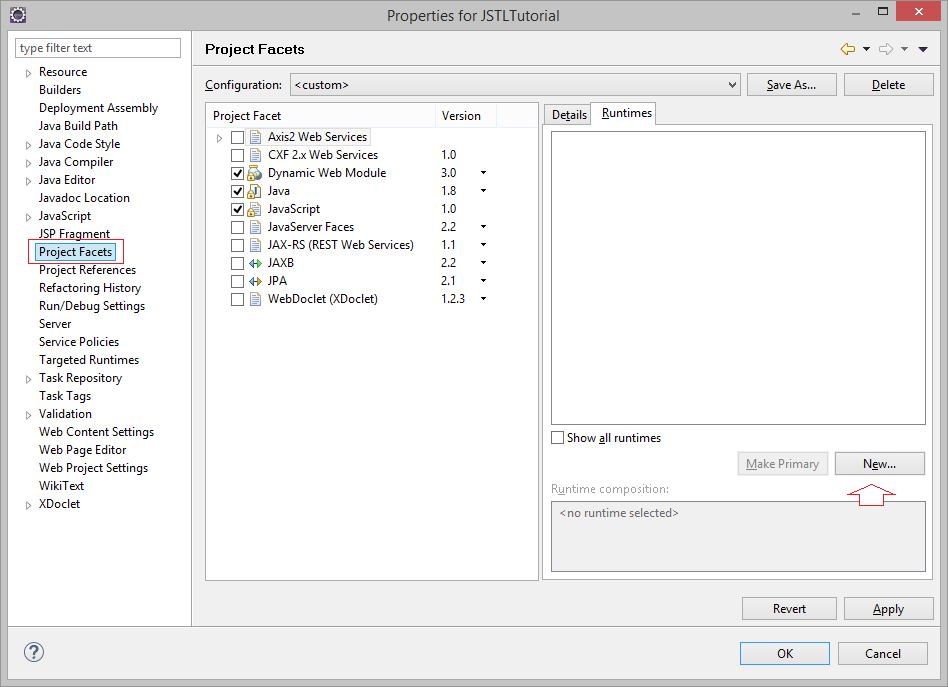
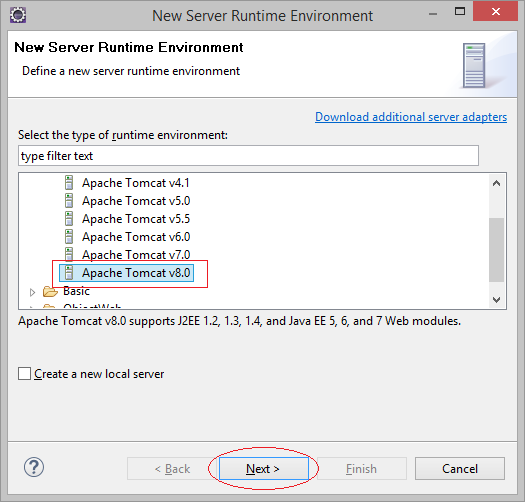
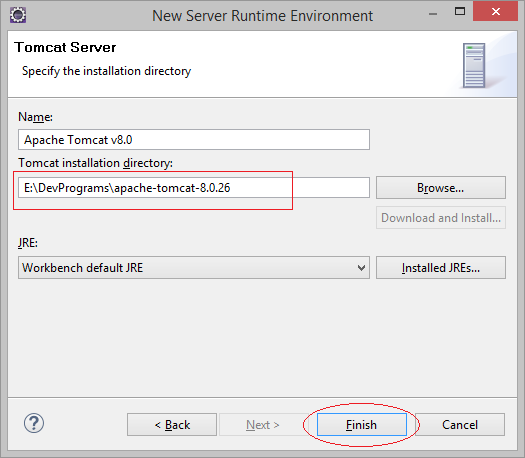
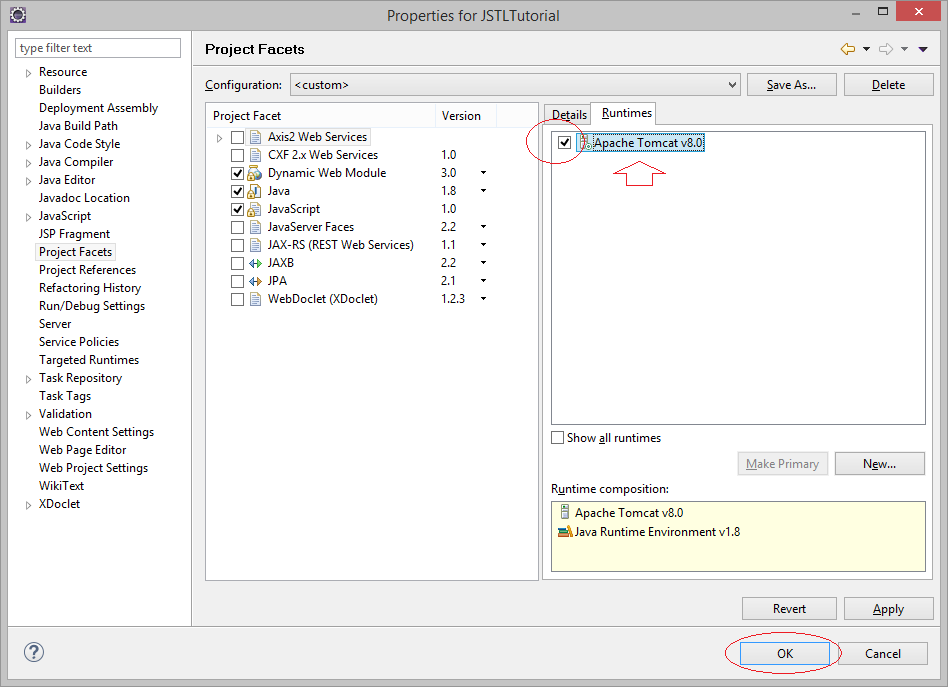
- Run As/Run on Server


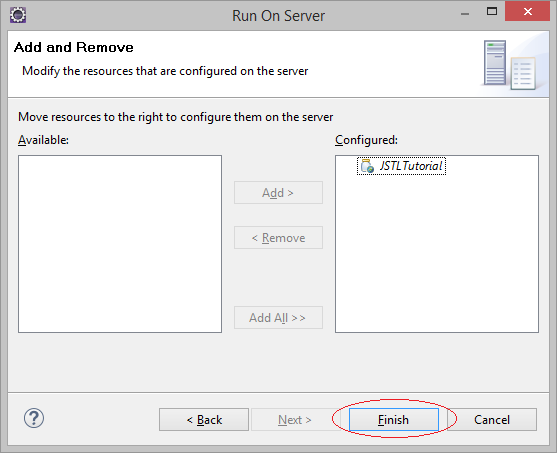
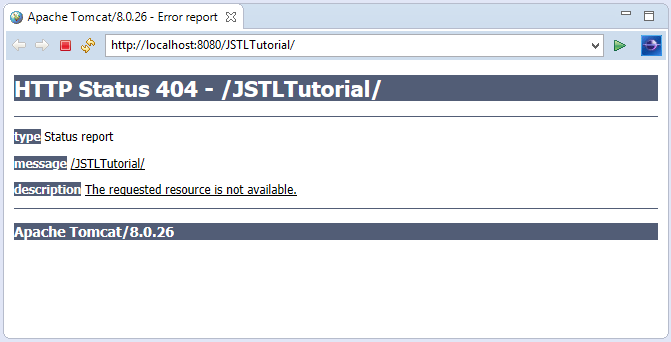
7. Les classes ont participé dans les exemples
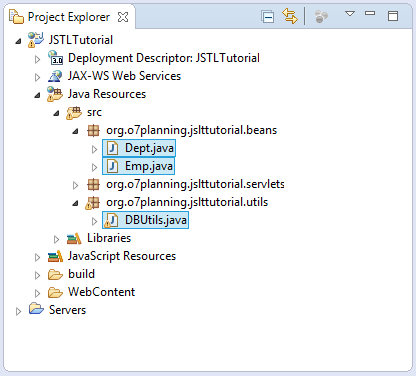
package org.o7planning.jslttutorial.beans;
import java.util.HashSet;
import java.util.Set;
public class Dept {
private int deptNo;
private String deptName;
private String location;
private Set<Emp> employees;
public Dept() {
}
public Dept(int deptNo, String deptName, String location) {
this.deptNo = deptNo;
this.deptName = deptName;
this.location = location;
}
public int getDeptNo() {
return deptNo;
}
public void setDeptNo(int deptNo) {
this.deptNo = deptNo;
}
public String getDeptName() {
return deptName;
}
public void setDeptName(String deptName) {
this.deptName = deptName;
}
public String getLocation() {
return location;
}
public void setLocation(String location) {
this.location = location;
}
public Set<Emp> getEmployees() {
return employees;
}
public void setEmployees(Set<Emp> employees) {
this.employees = employees;
}
public void addEmployee(Emp employee) {
if(this.employees== null) {
this.employees= new HashSet<Emp>();
}
this.employees.add(employee);
}
}package org.o7planning.jslttutorial.beans;
import java.text.DateFormat;
import java.text.ParseException;
import java.text.SimpleDateFormat;
import java.util.Date;
public class Emp {
private int empNo;
private String empName;
private String job;
private Date hireDate;
private float salary;
private static final DateFormat df = new SimpleDateFormat("MM/dd/yyyy");
public Emp() {
}
// @hireDateStr - must have the format 'MM/dd/yyyy'.
public Emp(int empNo, String empName, String job,
String hireDateStr, float salary) {
this.empNo = empNo;
this.empName = empName;
this.job = job;
this.salary = salary;
try {
this.hireDate = df.parse(hireDateStr);
} catch (ParseException e) {
throw new RuntimeException(e);
}
}
public int getEmpNo() {
return empNo;
}
public void setEmpNo(int empNo) {
this.empNo = empNo;
}
public String getEmpName() {
return empName;
}
public void setEmpName(String empName) {
this.empName = empName;
}
public String getJob() {
return job;
}
public void setJob(String job) {
this.job = job;
}
public Date getHireDate() {
return hireDate;
}
public void setHireDate(Date hireDate) {
this.hireDate = hireDate;
}
public float getSalary() {
return salary;
}
public void setSalary(float salary) {
this.salary = salary;
}
}package org.o7planning.jslttutorial.utils;
import java.util.ArrayList;
import java.util.List;
import java.util.Set;
import org.o7planning.jslttutorial.beans.Dept;
import org.o7planning.jslttutorial.beans.Emp;
public class DBUtils {
private static final List<Dept> DEPARTMENTS = new ArrayList<Dept>();
static {
initData();
}
// La simulation des données dans la base de données.
private static void initData() {
Dept accountingDept = new Dept(10, "ACCOUNTING", "NEW YORK");
accountingDept.addEmployee(new Emp(7782, "CLARK", "MANAGER", "6/9/1981", 2450.00f));
accountingDept.addEmployee(new Emp(7839, "KING", "PRESIDENT", "11/17/1981", 5000.00f));
accountingDept.addEmployee(new Emp(7934, "MILLER", "CLERK", "6/9/1981", 1300.00f));
//
Dept reseachDept = new Dept(20, "RESEARCH", "DALLAS");
reseachDept.addEmployee(new Emp(7369, "SMITH", "CLERK", "12/17/1980", 800.00f));
reseachDept.addEmployee(new Emp(7788, "SCOTT", "ANALYST", "4/19/1987", 3000.00f));
reseachDept.addEmployee(new Emp(7876, "ADAMS", "CLERK", "5/23/1987", 1100.00f));
reseachDept.addEmployee(new Emp(7876, "FORD", "ANALYST", "12/3/1981", 3000.00f));
reseachDept.addEmployee(new Emp(7566, "JONES", "MANAGER", "4/2/1981", 2975.00f));
//
//
Dept salesDept = new Dept(30, "SALES", "CHICAGO");
salesDept.addEmployee(new Emp(7654, "MARTIN", "SALESMAN", "9/28/1981", 1250.00f));
salesDept.addEmployee(new Emp(7499, "ALLEN", "SALESMAN", "2/20/1981", 1600.00f));
salesDept.addEmployee(new Emp(7521, "WARD", "SALESMAN", "2/22/1981", 1250.00f));
salesDept.addEmployee(new Emp(7844, "TURNER", "SALESMAN", "9/8/1981", 1500.00f));
salesDept.addEmployee(new Emp(7900, "JAMES", "CLERK", "12/3/1981", 950.00f));
//
Dept openrationsDept = new Dept(40, "OPERATIONS", "BOSTON");
//
DEPARTMENTS.add(accountingDept);
DEPARTMENTS.add(reseachDept);
DEPARTMENTS.add(salesDept);
DEPARTMENTS.add(openrationsDept);
}
// La requête de la tableau Department.
public static List<Dept> queryDepartments() {
return DEPARTMENTS;
}
// La requête de la tableau Employee.
// Obtenez la liste des employés dans un département.
public static Set<Emp> queryEmployees(int deptNo) {
for (Dept dept : DEPARTMENTS) {
if (deptNo == dept.getDeptNo()) {
return dept.getEmployees();
}
}
return null;
}
}8. Les tages basiques de JSTL (JSTL Core Tags)
Tag | Description |
<c:out> | To write something in JSP page, you can use EL also with this tag |
<c:import> | Same as <jsp:include> or include directive |
<c:redirect> | redirect request to another resource |
<c:set> | To set the variable value in given scope. |
<c:remove> | To remove the variable from given scope |
<c:catch> | To catch the exception and wrap it into an object. |
<c:if> | Simple conditional logic, used with EL and you can use it to process the exception from <c:catch> |
<c:choose> | Simple conditional tag that establishes a context for mutually exclusive conditional operations, marked by <c:when> and <c:otherwise> |
<c:when> | Subtag of <c:choose> that includes its body if its condition evalutes to ‘true’. |
<c:otherwise> | Subtag of <c:choose> that includes its body if its condition evalutes to ‘false’. |
<c:forEach> | for iteration over a collection |
<c:forTokens> | for iteration over tokens separated by a delimiter. |
<c:param> | used with <c:import> to pass parameters |
<c:url> | to create a URL with optional query string parameters |
Égaux à
(equals) | == | eq |
Pas égaux
(Not equals) | != | ne |
Moins que (Less than) | < | lt |
Plus grand que(Greater than) | > | gt |
Moins que ou égaux à
(Less than or equals) | <= | le |
Plus grand ou égaux à
(Greater than or equals) | >= | ge |
Concept | Condition EL | Résultat |
Numérique inférieur à | ${1 < 2} | vrai |
Numérique supérieur à | ${1 > 2} | faux |
Numérique inférieur à
(Less than) | ${1 lt 2} | vrai |
Numérique supérieur à
(Greater than) | ${1 gt 2} | faux |
Numérique supérieur ou égal à | ${1 >= 1} | vrai |
Numérique inférieur ou égal à | ${1 <= 1} | vrai |
Numérique inférieur ou égal à
(Less equals) | ${1 le 1} | vrai |
Numérique supérieur ou égal à
(Greater than or equal) | ${1 ge 1} | vrai |
Numérique égal à | ${1 == 1} | vrai |
Numérique égal à
(equal) | ${1 eq 1} | vrai |
Numérique non égal à | ${1 != 2} | vrai |
Numérique non égal à
(not equal) | ${1 ne 2} | vrai |
Alphabétique moins que | ${'abe' < 'ade'} | vrai |
Alphabétique supérieur que | ${'abe' > 'ade'} | faux |
Alphabétique égal à
(Equals) | ${'abe' eq 'abe'} | vrai |
Alphabétique non égal à
(Not equals) | ${'abe' ne 'ade'} | vrai |
Opérateur | Description |
&& | Et |
|| | Ou |
${(guess >= 10) && (guess <= 20)} | ${ guess >= 10 && guess <= 20 } |
${(guess < 10) || (guess > 20)} | ${ guess < 10 || guess > 20 } |
Si vous ne voulez pas que des utilisateurs accèdent directement à la page JSP, vous pouvez les placer dans le répertoire WEB-INF ou les sous-répertoires de ce répertoire.
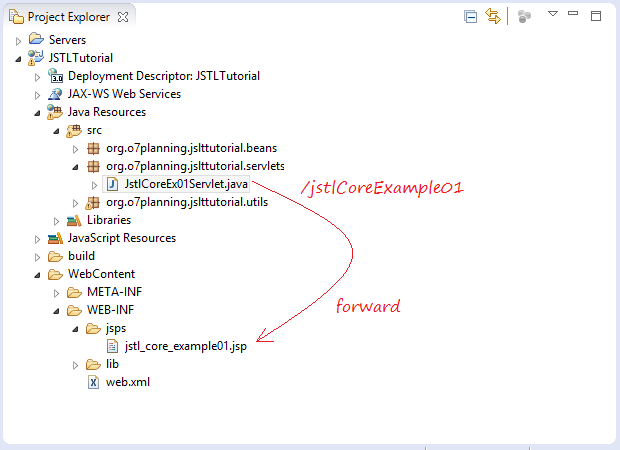
// Obtenez des données de DB (La simulation).
List<Dept> list = DBUtils.queryDepartments();
// Stockez des données dans l'attribut 'departments' de la demande.
request.setAttribute("departments", list);<c:forEach items="${requestScope.departments}" var="dept">
${dept.deptName}
</c:forEach>
<!-- Or (no need requestScope) -->
<c:forEach items="${departments}" var="dept">
${dept.deptName}
</c:forEach>package org.o7planning.jslttutorial.servlets;
import java.io.IOException;
import java.util.List;
import javax.servlet.RequestDispatcher;
import javax.servlet.ServletException;
import javax.servlet.annotation.WebServlet;
import javax.servlet.http.HttpServlet;
import javax.servlet.http.HttpServletRequest;
import javax.servlet.http.HttpServletResponse;
import org.o7planning.jslttutorial.beans.Dept;
import org.o7planning.jslttutorial.utils.DBUtils;
@WebServlet("/jstlCoreExample01")
public class JstlCoreEx01Servlet extends HttpServlet {
private static final long serialVersionUID = 1L;
public JstlCoreEx01Servlet() {
super();
}
@Override
protected void doGet(HttpServletRequest request, HttpServletResponse response)
throws ServletException, IOException {
// Demandez des données de DB (Simulation).
List<Dept> list = DBUtils.queryDepartments();
// Stockez des données dans l'attribut 'departments' de la demande.
request.setAttribute("departments", list);
// Créez l'objet RequestDispatcher
// afin de Forward (Transmettre) la demande à jstl_core_example01.jsp
RequestDispatcher dispatcher = getServletContext()
.getRequestDispatcher("/WEB-INF/jsps/jstl_core_example01.jsp");
// Forward (Transmettre) la demande, afin d'afficher des données sur la page JSP.
dispatcher.forward(request, response);
}
@Override
protected void doPost(HttpServletRequest request, HttpServletResponse response)
throws ServletException, IOException {
doGet(request, response);
}
}<%@ page language="java" contentType="text/html; charset=UTF-8"
pageEncoding="UTF-8"%>
<%@ taglib uri="http://java.sun.com/jsp/jstl/core" prefix="c" %>
<!DOCTYPE html>
<html>
<head>
<meta charset="UTF-8">
<title>JSTL Core Tags Example 01</title>
</head>
<body>
<h2>Departments and Employees</h2>
<c:forEach items="${departments}" var="dept">
<h3>${dept.deptName}</h3>
<ul>
<c:forEach items="${dept.employees}" var="emp">
<li>
${emp.empName} - (${emp.job})
</li>
</c:forEach>
</ul>
</c:forEach>
</body>
</html>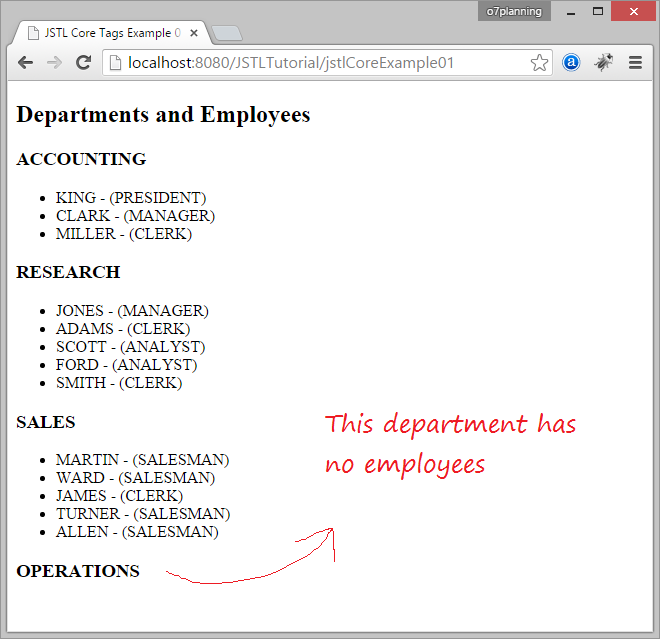
package org.o7planning.jslttutorial.servlets;
import java.io.IOException;
import java.util.List;
import javax.servlet.RequestDispatcher;
import javax.servlet.ServletException;
import javax.servlet.annotation.WebServlet;
import javax.servlet.http.HttpServlet;
import javax.servlet.http.HttpServletRequest;
import javax.servlet.http.HttpServletResponse;
import org.o7planning.jslttutorial.beans.Dept;
import org.o7planning.jslttutorial.utils.DBUtils;
@WebServlet("/jstlCoreExample02")
public class JstlCoreEx02Servlet extends HttpServlet {
private static final long serialVersionUID = 1L;
public JstlCoreEx02Servlet() {
super();
}
@Override
protected void doGet(HttpServletRequest request, HttpServletResponse response)
throws ServletException, IOException {
// Préparez des données de DB (Simulation).
List<Dept> list = DBUtils.queryDepartments();
// Stockez des données dans l'attribut (attribute) 'departments' de la demande.
request.setAttribute("departments", list);
// Créez l'objet RequestDispatcher
// pour forward (transmettre) la demande à jstl_core_example02.jsp
RequestDispatcher dispatcher = getServletContext()
.getRequestDispatcher("/WEB-INF/jsps/jstl_core_example02.jsp");
// Forward (Transmettre) la demande, pour l'afficher sur la page JSP.
dispatcher.forward(request, response);
}
@Override
protected void doPost(HttpServletRequest request, HttpServletResponse response)
throws ServletException, IOException {
doGet(request, response);
}
}<%@ page language="java" contentType="text/html; charset=UTF-8"
pageEncoding="UTF-8"%>
<%@ taglib uri="http://java.sun.com/jsp/jstl/core" prefix="c" %>
<!DOCTYPE html>
<html>
<head>
<meta charset="UTF-8">
<title>JSTL Core Tags Example 01</title>
</head>
<body>
<h2>Departments and Employees</h2>
<c:forEach items="${departments}" var="dept">
<!-- Check if collection is not null or not empty -->
<c:if test="${not empty dept.employees}">
<h3>${dept.deptName}</h3>
<ul>
<c:forEach items="${dept.employees}" var="emp">
<li>
${emp.empName} - (${emp.job})
</li>
</c:forEach>
</ul>
</c:if>
</c:forEach>
</body>
</html>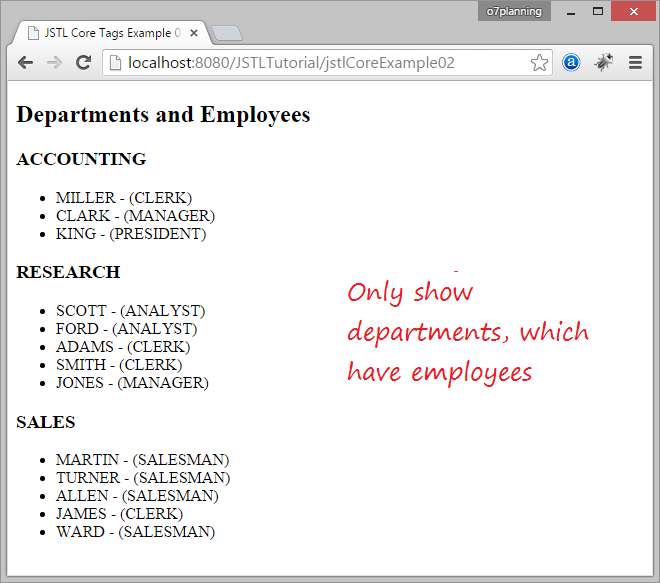
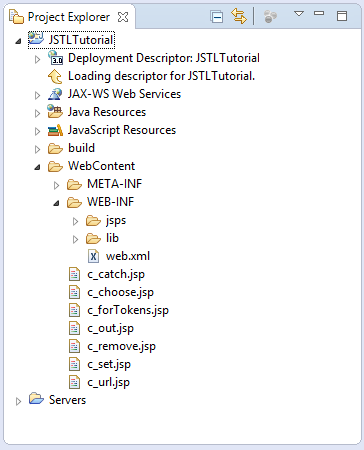
<c:choose>
<c:when test="${condition1}">
<%-- do something if condition1 is true --%>
</c:when>
<c:when test="${condition2}">
<%-- do something if condition2 is true --%>
</c:when>
<c:otherwise>
<%-- Statements which gets executed when all <c:when> tests are false. --%>
</c:otherwise>
</c:choose><%@ taglib uri="http://java.sun.com/jsp/jstl/core" prefix="c" %>
<!DOCTYPE html>
<html>
<head>
<meta charset="UTF-8">
<title>c:choose,c:when,c:otherwise example</title>
</head>
<body>
<h2>c:choose,c:when,c:otherwise example</h2>
<c:choose>
<%-- When color parameter == 'red' --%>
<c:when test="${param.color=='red'}">
<p style="color:red;">RED COLOR</p>
</c:when>
<%-- When color parameter == 'blue' --%>
<c:when test="${param.color=='blue'}">
<p style="color:blue;">BLUE COLOR</p>
</c:when>
<%-- Otherwise --%>
<c:otherwise>
<b>Other color</b>
</c:otherwise>
</c:choose>
</body>
</html>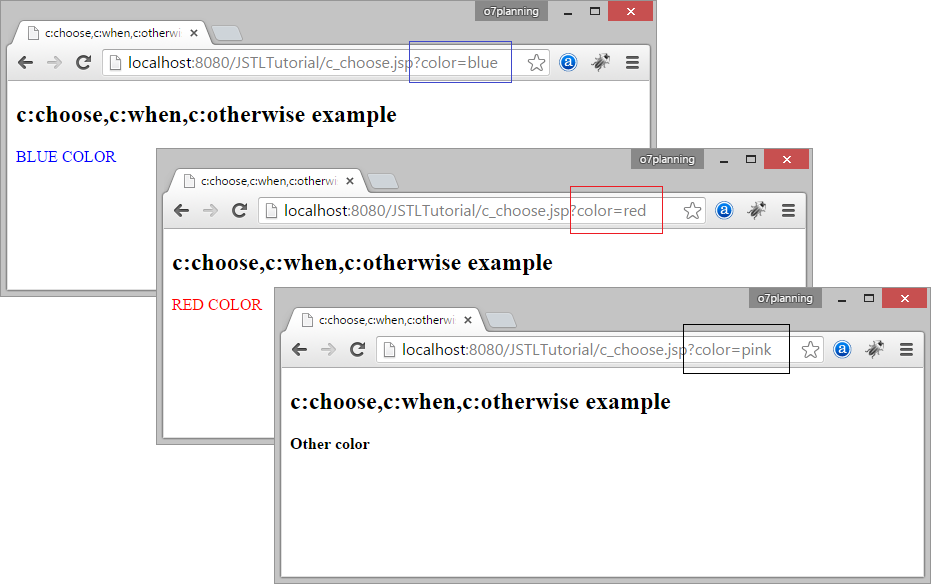
escape signifie que s'il y a des caractères particuliers < > ou & se trouvent dans <c:out> quand vous imprimez, ils vons transformer en < et > ẻt &
- Par exemple:
- <c:out value = "${'<atag> &'}" />
- Les résultats donnent quand vous les imprimez (Voyez dans la source de la page de navigation).
- <atag< &
<%@ taglib uri="http://java.sun.com/jsp/jstl/core" prefix="c" %>
<!DOCTYPE html>
<html>
<head>
<meta charset="UTF-8">
<title>c:out example</title>
</head>
<body>
<h2>c:out example</h2>
<c:out value="${'This is true: 10 > 1 '}" />
<br/>
Tag: <c:out value="${'<atag> , &'}"/>
</body>
</html>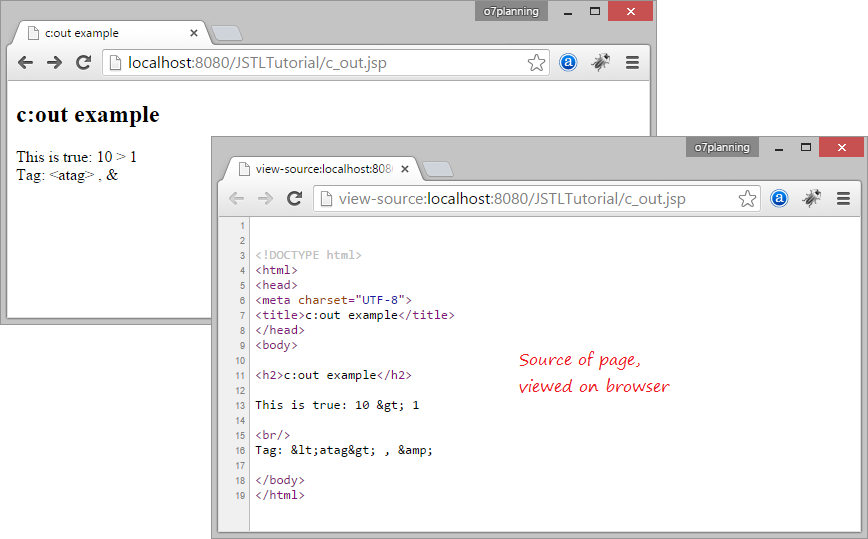
<%@ taglib uri="http://java.sun.com/jsp/jstl/core" prefix="c" %>
<!DOCTYPE html>
<html>
<head>
<meta charset="UTF-8">
<title>c:set example</title>
</head>
<body>
<h2>c:set example</h2>
<c:set scope="request" var="greeting" value="Hello every body" />
Greeting: <c:out value="${greeting}"/>
</body>
</html>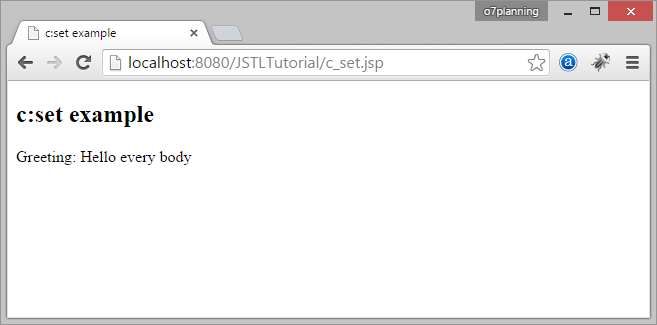
<%@ taglib uri="http://java.sun.com/jsp/jstl/core" prefix="c" %>
<!DOCTYPE html>
<html>
<head>
<meta charset="UTF-8">
<title>c:remove example</title>
</head>
<body>
<h2>c:remove example</h2>
<c:set scope="request" var="greeting" value="Hello every body" />
Greeting: <c:out value="${greeting}"/>
<br/><br/>
<c:remove scope="request" var="greeting" />
After remove:
<br/>
Greeting: <c:out value="${greeting}"/>
</body>
</html>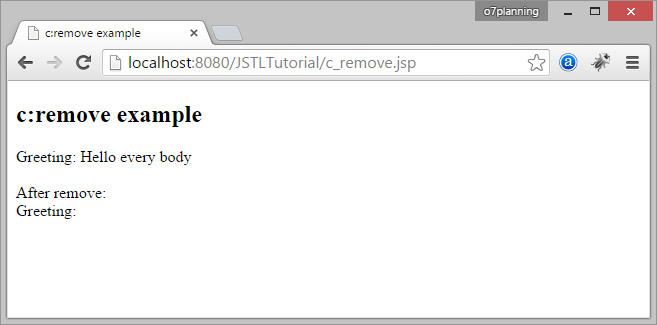
<%@ taglib uri="http://java.sun.com/jsp/jstl/core" prefix="c" %>
<!DOCTYPE html>
<html>
<head>
<meta charset="UTF-8">
<title>c:catch example</title>
</head>
<body>
<h2>c:catch example</h2>
<c:catch var ="ex">
<%
int a = 100/0;
%>
</c:catch>
<c:if test = "${ex != null}">
Exception : ${ex}
<br />
Message: ${ex.message}
</c:if>
</body>
</html>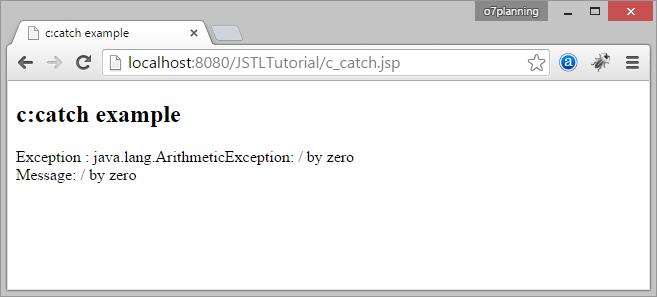
<%@ taglib uri="http://java.sun.com/jsp/jstl/core" prefix="c" %>
<!DOCTYPE html>
<html>
<head>
<meta charset="UTF-8">
<title>c:forTokens example</title>
</head>
<body>
<h2>c:forTokens example</h2>
<c:forTokens items="Tom,Jerry,Donald" delims="," var="name">
<c:out value="${name}"/><p>
</c:forTokens>
</body>
</html>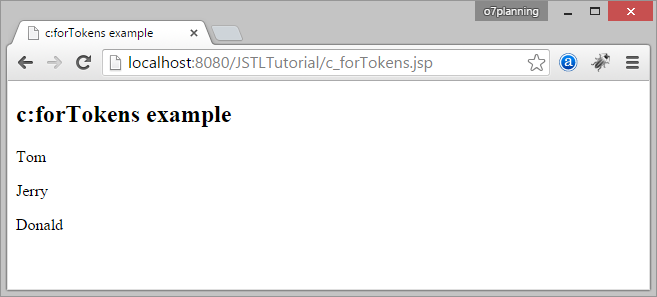
<%@ taglib uri="http://java.sun.com/jsp/jstl/core" prefix="c" %>
<!DOCTYPE html>
<html>
<head>
<meta charset="UTF-8">
<title>c:url,c:param example</title>
</head>
<body>
<h2>c:url,c:param example</h2>
<c:url value="http://example.com/showPage.jsp" var="myURL">
<c:param name="color" value="red"/>
<c:param name="background" value="blue"/>
</c:url>
<c:out value="${myURL}"/>
</body>
</html>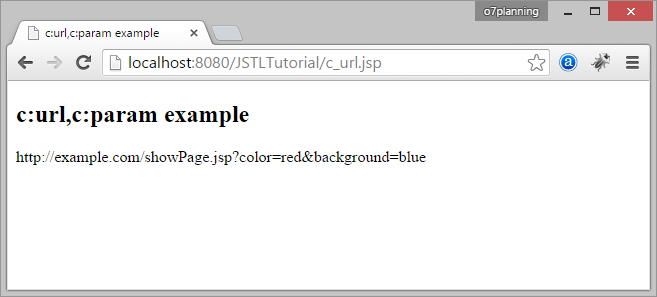
9. JSTL Formatting and Localization Tags
Tag | Description |
<fmt:formatNumber> | To render numerical value with specific precision or format. |
<fmt:parseNumber> | Parses the string representation of a number, currency, or percentage. |
<fmt:formatDate> | Formats a date and/or time using the supplied styles and pattern |
<fmt:parseDate> | Parses the string representation of a date and/or time |
<fmt:bundle> | Loads a resource bundle to be used by its tag body. |
<fmt:setLocale> | Stores the given locale in the locale configuration variable. |
<fmt:setBundle> | Loads a resource bundle and stores it in the named scoped variable or the bundle configuration variable. |
<fmt:timeZone> | Specifies the time zone for any time formatting or parsing actions nested in its body. |
<fmt:setTimeZone> | Stores the given time zone in the time zone configuration variable |
<fmt:message> | To display an internationalized message. |
<fmt:requestEncoding> | Sets the request character encoding |
<fmt:formatNumber
value="<number>"
type="<string>"
pattern="<string>"
currencyCode="<string>"
currencySymbol="<string>"
groupingUsed="<string>"
maxIntegerDigits="<integer>"
minIntegerDigits="<integer>"
maxFractionDigits="<integer>"
minFractionDigits="<integer>"
var="<string>"
scope="<string>"/>Name | Required | Type | Default | Description |
value | Yes | Number | Numeric value to be formatted. | |
type | String | number | Determines whether the value is formatted as a number, currency or percentage. | |
pattern | String | Formatting pattern. | ||
currencyCode | String | From the default locale | The currency code to be used if the type attribute is currency. | |
currencySymbol | String | From the default locale | The currency symbol to be used if the type attribute is currency. | |
groupingUsed | String | true | Whether any grouping separated to be used when formatting the output. | |
maxIntegerDigits | Integer | Maximum number of digits in the integer portion. | ||
minIntegerDigits | Integer | Minimum number of digits in the integer portion. | ||
maxFractionDigits | Integer | Maximum number of digits in the fraction portion. | ||
minFractionDigits | Integer | Minimum number of digits in the fraction portion. | ||
var | String | Print to page | Name of the variable which stores the formatted result. | |
scope | String | Scope to store the var. |
<%@ taglib uri="http://java.sun.com/jsp/jstl/core" prefix="c" %>
<%@ taglib uri="http://java.sun.com/jsp/jstl/fmt" prefix="fmt" %>
<!DOCTYPE html>
<html>
<head>
<meta charset="UTF-8">
<title>fmt:formatNumber example</title>
</head>
<body>
<h2>fmt:formatNumber example</h2>
<c:set var="accountBalance" value="12345.6789" />
<h3>accountBalance=<c:out value="${accountBalance}"/></h3>
The Account Balance can be displayed using various ways:
<p>
formatNumber (type='currency'):
<strong>
<fmt:formatNumber value="${accountBalance}" type="currency"/>
</strong>
</p>
<p>
formatNumber (type='number', maxIntegerDigits= '3'):
<strong>
<fmt:formatNumber type="number" maxIntegerDigits="3" value="${accountBalance}" />
</strong>
</p>
<p>
formatNumber (type='number', maxFractionDigits= '3'):
<strong>
<fmt:formatNumber type="number" maxFractionDigits="3" value="${accountBalance}" />
</strong>
</p>
<p>
formatNumber (type='number', groupingUsed= 'false'):
<strong>
<fmt:formatNumber type="number" groupingUsed="false" value="${accountBalance}" />
</strong>
</p>
<p>
formatNumber (type='percent', maxIntegerDigits= '3'):
<strong>
<fmt:formatNumber type="percent" maxIntegerDigits="3" value="${accountBalance}" />
</strong>
</p>
<p>
formatNumber (type='percent', maxIntegerDigits= '10'):
<strong>
<fmt:formatNumber type="percent" minFractionDigits="10" value="${accountBalance}" />
</strong>
</p>
<p>
formatNumber (type='number', pattern= '###.###E0'):
<strong>
<fmt:formatNumber type="number" pattern="###.###E0" value="${accountBalance}" />
</strong>
</p>
<p>
Account Balance in USA (fmt:setLocale value='en_US'):
<br/>
formatNumber (type='currency'):
<fmt:setLocale value="en_US"/>
<strong>
<fmt:formatNumber value="${accountBalance}" type="currency"/>
</strong>
<p>
Account Balance in Canada (fmt:setLocale value='fr_CA'):
<br/>
formatNumber (type='currency'):
<fmt:setLocale value="fr_CA"/>
<strong>
<fmt:formatNumber value="${accountBalance}" type="currency"/>
</strong>
</body>
</html>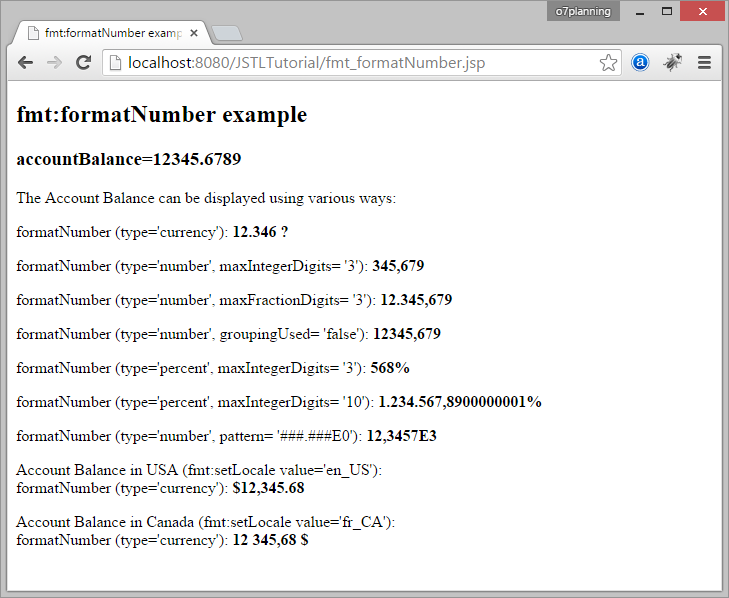
<fmt:parseNumber
value="<string>"
type="<string>"
pattern="<string>"
parseLocale="<string>"
integerOnly="<string>"
var="<string>"
scope="<string>"/>Name | Required | Type | Default | Description |
value | Yes | String | String to be parsed. | |
type | String | number | Determines whether the String provided in the value attribute to be parsed as a NUMBER, CURRENRY or PERCENTAGE. Default is NUMBER. | |
pattern | String | Pattern on how the given string in the value attribute is parsed. | ||
parseLocale | String | Default locale | Locale to use when parsing the value using the given pattern. | |
integerOnly | String | false | Specifies whether only the integer part of the value is parsed. | |
var | String | Print to page | Name of the variable which stores the result of the parsed value. The result is of type java.lang.Number. | |
scope | String | page | Scope for the var to store. |
<%@ taglib uri="http://java.sun.com/jsp/jstl/core" prefix="c" %>
<%@ taglib uri="http://java.sun.com/jsp/jstl/fmt" prefix="fmt" %>
<!DOCTYPE html>
<html>
<head>
<meta charset="UTF-8">
<title>fmt:parseNumber example</title>
</head>
<body>
<h2>fmt:parseNumber example</h2>
<!-- a String in currency format -->
<c:set var="accountBalance" value="$12345.6789" />
<h4>Input <c:out value="${accountBalance}"/></h4>
<fmt:parseNumber var="parsedNumber" type="currency"
parseLocale="en_US"
value="${accountBalance}" />
<p>Account Balance: <c:out value="${parsedNumber}" /></p>
<!-- integerOnly="true" : Specifies whether only
the integer part of the value is parsed. -->
<fmt:parseNumber var="parsedNumber" type="currency"
integerOnly="true" parseLocale="en_US"
value="${accountBalance}" />
<p>Account Balance (without cents): <c:out value="${parsedNumber}" /></p>
</body>
</html>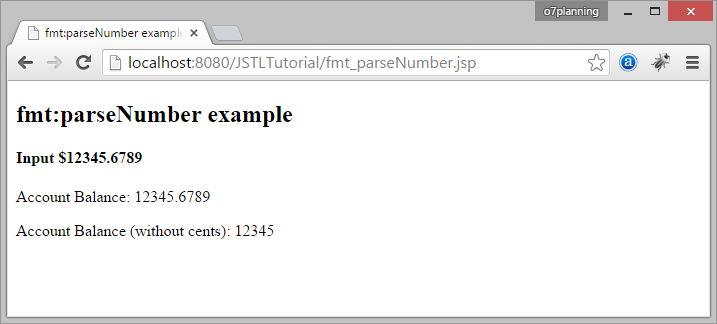
Name | Required | Type | Default | Description |
value | True | Date | Date or time to be formatted. | |
type | False | String | date | Determines whether date or time or both to be formatted in the given date. |
dateStyle | False | String | default | Formatting style for date. The date format can be specified with similar semantics in class java.text.DateFormat. |
timeStyle | False | String | default | Formatting style for time. The time format can be specified with similar semantics in class java.text.DateFormat. |
pattern | False | String | Pattern to be used for date and time when formatting. | |
timeZone | False | String | Default time zone | Time zone to represent for the formatted time. |
var | False | String | Print to Page | Name of the variable to store the resulted formatted date or time. |
scope | False | String | page | Scope to store the var. |
Code | Purpose | Sample |
G | The era designator | AD |
y | The year | 2002 |
M | The month | April & 04 |
d | The day of the month | 20 |
h | The hour(12-hour time) | 12 |
H | The hour(24-hour time) | 0 |
m | The minute | 45 |
s | The second | 52 |
S | The millisecond | 970 |
E | The day of the week | Tuesday |
D | The day of the year | 180 |
F | The day of the week in the month | 2 (2nd Wed in month) |
w | The week in the year | 27 |
W | The week in the month | 2 |
a | The a.m./p.m. indicator | PM |
k | The hour(12-hour time) | 24 |
K | The hour(24-hour time) | 0 |
z | The time zone | Central Standard Time |
' | The escape for text | |
'' | The single quote |
<%@ page language="java" contentType="text/html; charset=UTF-8"
pageEncoding="UTF-8"%>
<%@ taglib uri="http://java.sun.com/jsp/jstl/core" prefix="c" %>
<%@ taglib uri="http://java.sun.com/jsp/jstl/fmt" prefix="fmt" %>
<!DOCTYPE html>
<html>
<head>
<meta charset="UTF-8">
<title>fmt:formatDate example</title>
</head>
<body>
<h2>fmt:formatDate example</h2>
<c:set var="now" value="<%=new java.util.Date()%>" />
<p>
Time (fmt:formatDate type="time"):
<strong>
<fmt:formatDate type="time" value="${now}" />
</strong>
</p>
<p>
Date (fmt:formatDate type="date"):
<strong>
<fmt:formatDate type="date" value="${now}" />
</strong>
</p>
<p>
Date, Time (fmt:formatDate type="both"):
<strong>
<fmt:formatDate type="both" value="${now}" />
</strong>
</p>
<p>
Date, Time Short (fmt:formatDate type="both" dateStyle="short"):
<strong>
<fmt:formatDate type="both" dateStyle="short" timeStyle="short" value="${now}" />
</strong>
</p>
<p>
Date, Time Medium (fmt:formatDate type="both" dateStyle="medium" timeStyle="medium"):
<strong>
<fmt:formatDate type="both" dateStyle="medium" timeStyle="medium" value="${now}" />
</strong>
</p>
<p>
Date, Time Long (fmt:formatDate type="both" dateStyle="long" timeStyle="long"):
<strong>
<fmt:formatDate type="both" dateStyle="long" timeStyle="long" value="${now}" />
</strong>
</p>
<p>
Date, Time (dd-MM-yyyy HH:mm:ss):
<strong>
<fmt:formatDate pattern="dd-MM-yyyy HH:mm:ss" value="${now}" />
</strong>
</p>
<!-- Store in variable -->
<fmt:formatDate pattern="dd-MM-yyyy HH:mm" value="${now}" var="nowString"/>
<p>
Now String (dd-MM-yyyy HH:mm):
<strong>
<c:out value="${nowString}" />
</strong>
</p>
</body>
</html>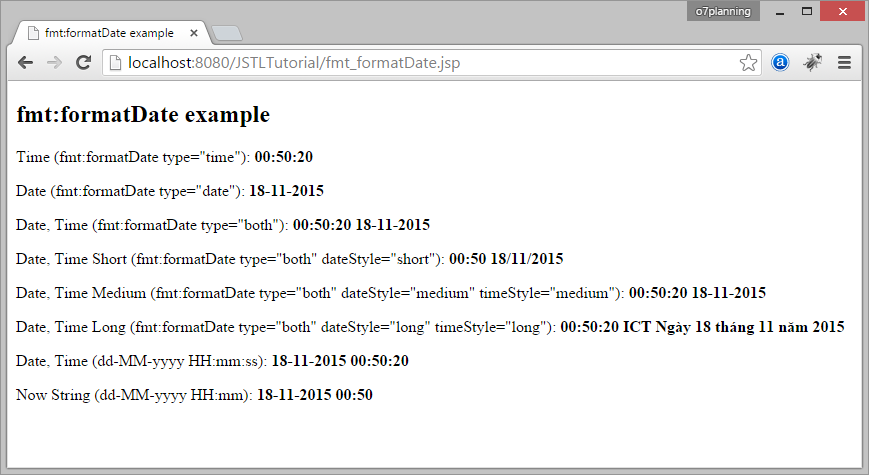
<fmt:parseDate
value="<string>"
type="<string>"
dateStyle="<string>"
timeStyle="<string>"
pattern="<string>"
timeZone="<string>"
parseLocale="<string>"
var="<string>"
scope="<string>"/>Name | Required | Type | Default | Description |
value | False | String | Body | The date string to be parsed. |
type | False | String | date | Determines whether value specified in the value attribute contains a date, time or both. |
dateStyle | False | String | default | Specifies date style (SHORT, LONG, FULL, MEDIUM or DEFAULT). |
timeStyle | False | String | default | Specifies time style (SHORT, LONG, FULL, MEDIUM or DEFAULT). |
pattern | False | String | Specifies the pattern on how the date string to be parsed. | |
timeZone | False | String | Default time zone | Time zone to interpret if date string contains any time information. |
parseLocale | False | String | Default Locale | Locale whose date time formatting will be used to parse the date time. |
var | False | String | Print to Page | Name of the variable to store the parsed result. |
scope | False | String | page | Scope to store the var. |
<%@ taglib uri="http://java.sun.com/jsp/jstl/core" prefix="c" %>
<%@ taglib uri="http://java.sun.com/jsp/jstl/fmt" prefix="fmt" %>
<!DOCTYPE html>
<html>
<head>
<meta charset="UTF-8">
<title>fmt:parseDate example</title>
</head>
<body>
<h2>fmt:parseDate example</h2>
<!-- a Date time string -->
<c:set var="dateTimeString" value="17-11-2015 11:49" />
<h4>
dateTimeString:
<c:out value="${dateTimeString}"/>
</h4>
<!-- Parsing a date time string, and store in a variable type of java.util.Date -->
<fmt:parseDate value="${dateTimeString}"
type="both" var="parsedDatetime" pattern="dd-MM-yyyy HH:mm" />
<p>
The date time after parsing:
<c:out value="${parsedDatetime}" />
</p>
<br/>
<p>
Date only (dd/MM/yyyy):
<fmt:formatDate value="${parsedDatetime}" pattern="dd/MM/yyyy"/>
</body>
</html>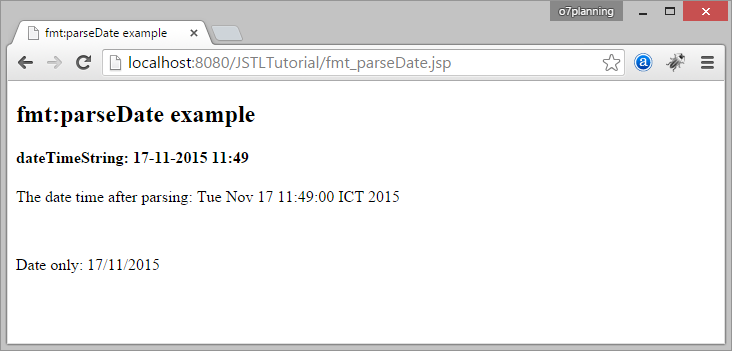
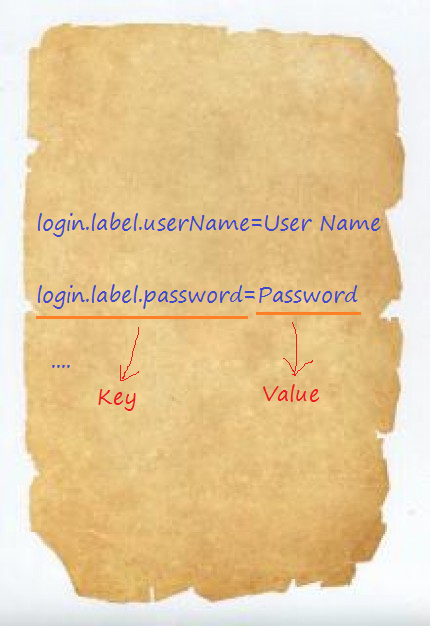
<fmt:bundle baseName="<string>" prefix="<string>"/>Name | Required | Type | Default | Description |
baseName | True | String | Resource bundle’s fully qualified name. Follows the Java’s fully qualified class name convention (‘.’ is used to separate the package names). For example: org.o7planning.MyBundle. | |
prefix | False | String | When used with <fmt:message> this attribute specifies the value to be prepended in the key value so that each time we do not have to provide the prefix repeatedly. |
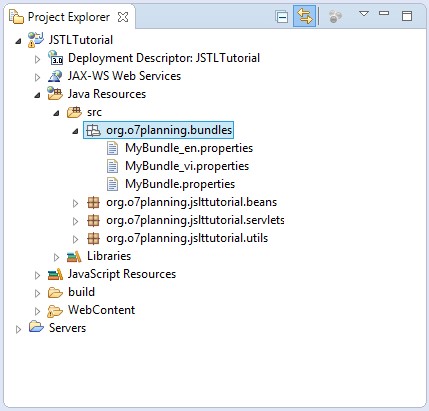
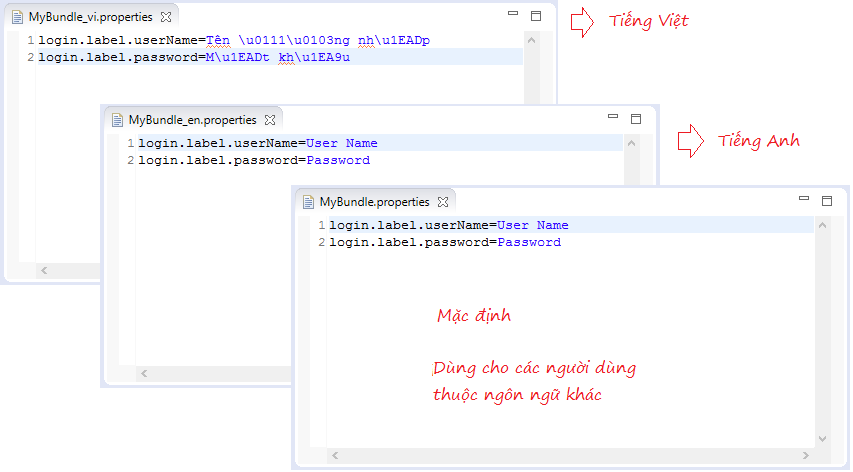
login.label.userName=User Name
login.label.password=Passwordlogin.label.userName=Tên \u0111\u0103ng nh\u1EADp
login.label.password=M\u1EADt kh\u1EA9uMalheureusement, lorsque les fichiers .properties sont lus via un ResourceBundle, il a toujours été lu avec le codage 'ISO-8859-1'. Vous ne pouvez pas utiliser Unicode dans le fichier properties. L'approche habituelle est d'Escapse des caractères Unicode dans le fichier Properties. Ensuite, il ressemblera à quelque chose comme ça:
Escapse ===>
- login.label.password=Mật khẩu
- login.label.password=M\u1EADt kh\u1EA9u
Lorsque vous tapez des caractères Unicode dans le fichier properties sur "Properties File Editor" d'Eclipse, ils automatiquement remplacent les caractères None-ASCII.
<%@ taglib uri="http://java.sun.com/jsp/jstl/core" prefix="c" %>
<%@ taglib uri="http://java.sun.com/jsp/jstl/fmt" prefix="fmt" %>
<c:if test="${not empty param.language}">
<c:set var="language" value="${param.language}" scope="session"/>
</c:if>
<fmt:setLocale value="${language}" />
<fmt:setBundle basename="org.o7planning.bundles.MyBundle" />
<!DOCTYPE html>
<html>
<head>
<meta charset="UTF-8">
<title>fmt:bundle example</title>
</head>
<body>
<h2>fmt:bundle example</h2>
<form action="">
<table border="0">
<tr>
<td>
<fmt:message key="login.label.userName"/>
</td>
<td>
<input type="text" name="userName" />
</td>
</tr>
<tr>
<td>
<fmt:message key="login.label.password"/>
</td>
<td><input type="text" name="userName" /></td>
</tr>
</table>
<input type="submit" value="Submit"/>
</form>
</body>
</html>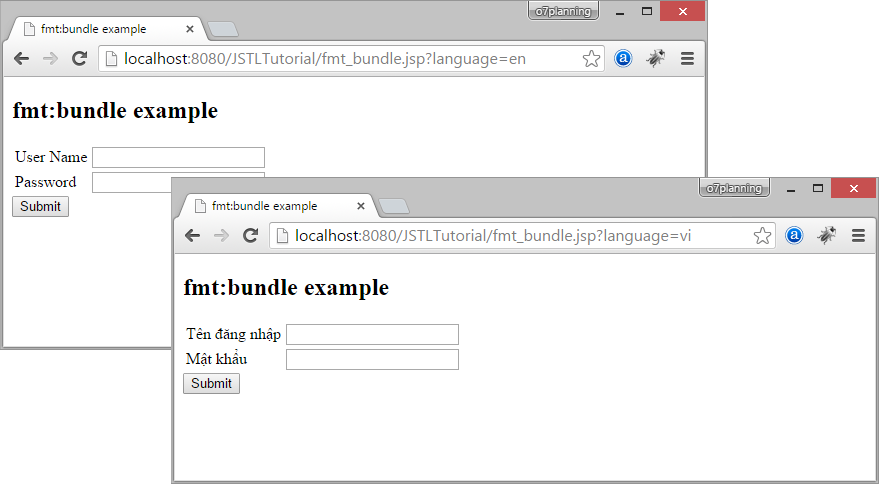
Remarque:<!-- If the user has used one language on a page, variable 'language' in 'session' scope, its value will stored in user session, and the website will be displayed in that language, if the parameters of the page does not specify different values for it. --> <c:set var="language" value="${param.language}" scope="session"/> <fmt:setLocale value="${language}" />
<fmt:message
key="<string>"
bundle="<string>"
var="<string>"
scope="<string>"/>Name | Required | Type | Default | Description |
key | False | String | Body | Key of the message to be looked up from the resource bundle. |
bundle | False | String | Default bundle | Which resource bundle the key to be looked up. |
var | False | String | Print to Page | Name of the variable to store the localized message. |
scope | False | String | page | The scope in which the localized message variable to be stored. |
Tutoriels de programmation Java Servlet/JSP
- Installer Tomcat Server pour Eclipse
- Installer Glassfish Web Server sur Windows
- Exécutez l'application Web Java Maven dans Tomcat Maven Plugin
- Exécutez l'application Web Java Maven dans Jetty Maven Plugin
- Exécuter une tâche d'arrière-plan dans l'application Java Servlet
- Le Tutoriel de Java Servlet pour des débutants
- Le Tutoriel de Java Servlet Filter
- Le Tutoriel de Java JSP
- Le Tutoriel de Java JSP Standard Tag Library (JSTL)
- Installer Web Tools Platform pour Eclipse
- Créez une application de connexion simple et sécurisez les pages avec Java Servlet Filter
- Créer une application Web Java simple à l'aide de Servlet, JSP et JDBC
- Upload et Download de fichiers stockés sur le disque dur avec Java Servlet
- Télécharger et télécharger des fichiers à partir de la base de données à l'aide de Java Servlet
- Affichage une image dans une base de données avec Java Servlet
- Redirection 301, redirection permanente dans Java Servlet
- Comment redirige http en https automatiquement dans une application web de Java?
- Utiliser Google reCAPTCHA dans l'application Web Java